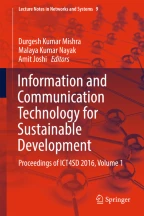Performance Evaluation of Data Mining Techniques

Data mining has gained immense popularity in various fields of medical, education and industry as well. Data mining is a process of predicting the result and extraction of useful information from huge dataset. In this paper, we have surveyed various data mining techniques. Further, performance of various data mining techniques, namely decision tree, random forest, naive Bayes, AdaBoost, multilayer perception neural network, radial basis function, sequential minimal optimization and decision stump, have been evaluated using UCI communities and crime dataset for classifying crime in US states. On the basis of results obtained, we found that the decision tree outperforms with 96.4% accuracy and minimal false-positive rate.
This is a preview of subscription content, log in via an institution to check access.
Access this chapter
Subscribe and save
Springer+ Basic
€32.70 /Month
- Get 10 units per month
- Download Article/Chapter or eBook
- 1 Unit = 1 Article or 1 Chapter
- Cancel anytime
Buy Now
Price includes VAT (France)
eBook EUR 160.49 Price includes VAT (France)
Softcover Book EUR 210.99 Price includes VAT (France)
Hardcover Book EUR 210.99 Price includes VAT (France)
Tax calculation will be finalised at checkout
Purchases are for personal use only
Similar content being viewed by others

Comparison of Decision Tree-Based Learning Algorithms Using Breast Cancer Data
Chapter © 2020

A Comparative Study of the Four Well-Known Classification Algorithms in Data Mining
Chapter © 2018

Performance Evaluation of Advanced Machine Learning Algorithms for Network Intrusion Detection System
Chapter © 2020
References
- Kirkos E, Spathis C (2007) Data mining techniques for the detection of fraudulent financial statements. Expert Syst Appl: Int J 995–1003 Google Scholar
- Merceron A, Yacef K (2005) Educational data mining: a case study. In: Proceedings of the 2005 conference on artificial intelligence in education: supporting learning through intelligent and socially informed technology. IOS Press, Amsterdam, Netherland, pp 467–474 Google Scholar
- Bâra A, Lungu I (2012) Improving decision support systems. In: Advances in data mining knowledge discovery and applications, pp 397–417 Google Scholar
- Lakshmi BN, Raghunandhan G (2011) A conceptual overview of data mining. In: 2011 national conference on innovations in emerging technology (NCOIET). IEEE, Erode, Tamil Nadu, pp 27–32 Google Scholar
- Purwar A, Singh SK (2014) Issues in data mining: a comprehensive survey. In: 2014 IEEE international conference on computational intelligence and computing research (ICCIC). IEEE, Coimbatore, pp 1–6 Google Scholar
- http://archive.ics.uci.edu/ml/
- Chen L, Li X, Yang Y (2016) Personal health indexing based on medical examinations. Decis Support Syst 54–65 Google Scholar
- Shouman M, Turner T (2012) Using data mining techniques in heart disease diagnosis and treatment. In: 2012 Japan-Egypt conference electronics, communications and computers (JEC-ECC). IEEE, Alexandria, pp 173–177 Google Scholar
- Kumar S, Toshniwal D (2015) A data mining framework to analyze road accident data. J Big Data Google Scholar
- Bahari TF, Elayidom MS (2015) An efficient CRM-data mining framework for the prediction of customer behaviour. In: Proceedings of the international conference on information and communication technologies, ICICT 2014. Elsevier, Kochi, pp 725–731 Google Scholar
- Anand SS, Grobelnik M (2007) Knowledge discovery standards. Artif Intell Rev 21–56 Google Scholar
- Han J, Kamber M (2012) Data mining concept and techniques. Elsevier, USA Google Scholar
- Crone SF, Lessmann S (2006) The impact of preprocessing on data mining: an evaluation of classifier sensitivity in direct marketing. Eur J Oper Res 781–800 Google Scholar
- Ramaswami M, Bhaskaran R (2009) A study on feature selection techniques in educational data mining. J Comput 7–11 Google Scholar
- Barros RC, Basgalupp MP (2012) A survey of evolutionary algorithms for decision-tree induction. IEEE Trans Syst Man Cybern Part C: Appl Rev Google Scholar
- Mantaras RL (1991) A distance-based attribute selection measure. Mach Learn 81–92 Google Scholar
- Quinlan JR (1986) Induction of decision trees. Mach Learn 81–106 Google Scholar
- Breiman L (2001) Random forests. Mach Learn 5–32 Google Scholar
- Kulkarni VY, Sinha PK (2013) Random forest classifiers: a survey and future research direction. Int J Adv Comput Google Scholar
- Breiman L (1996) Bagging predictor. Mach Learn 123–140 Google Scholar
- Schapire RE (2002) The boosting approach to machine learning: an overview. In: Nonlinear estimation and classification, pp 149–171 Google Scholar
- Platt JC (1999) Fast training of support vector machines using sequential minimal optimization. MIT Press, Cambridge, MA, USA Google Scholar
- Verma B (2002) Fast training of multilayer perceptrons. IEEE Trans Neural Netw 1314–1320 Google Scholar
- Delashmit WH, Manry MT (2005) Recent developments in multilayer perceptron neural networks. In: Proceedings of the 7th annual memphis area engineering and science conference Google Scholar
- Orr MJ (1996) Introduction to radial basis function network Google Scholar
- Oyang Y-J, Hwang S-C, Ou Y-Y, Chen CY, Chen ZW (2005) Data classification with radial basis function networks based on a novel kernel density estimation algorithm. IEEE Trans Neural Netw 225–236 Google Scholar
- Schapire RE (2013) Explaining AdaBoost. In: Empirical inference, pp 37–52 Google Scholar
- Choy M (2010) Building decision trees from decision stumps Google Scholar
- Iba W, Langley P (1992) Induction of one-level decision tree. In: Proceedings of the ninth international workshop on machine learning, ML ’92, USA, pp 233–240 Google Scholar
- Akinola OS, Afolabi AC (2012) Evaluating classification effectiveness on sequential minimal optimization (SMO) algorithm chemical parameterization of granitoids. IJRRAS Google Scholar
Author information
Authors and Affiliations
- USICT, Guru Gobind Singh Indraprastha University, Sector-16C, Dwarka, New Delhi, India Mani & Bharti Suri
- Ambedkar Institute of Advanced Communication Technologies and Research, Geeta Colony, New Delhi, India Manoj Kumar

